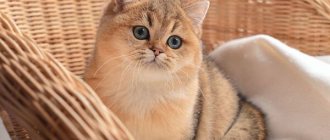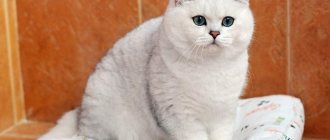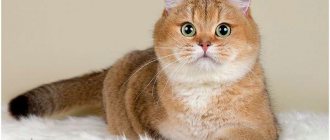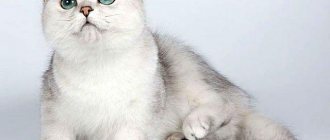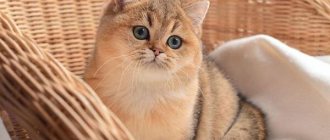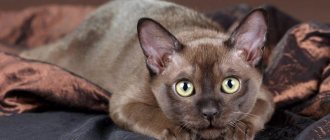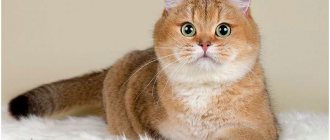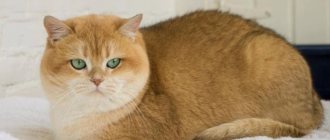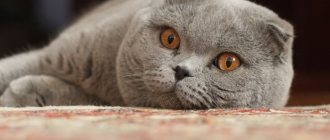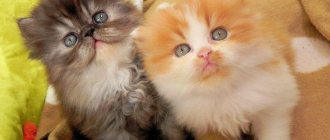The Persian chinchilla is a beautiful, stately cat with a short muzzle, expressive emerald eyes and a luxurious, elegant fur coat. Her exquisite appearance and aristocratic manners deserve the highest praise and become a source of pride for her owners.
And if you decide to buy a Persian chinchilla, you need to familiarize yourself with the characteristics of the breed in advance and ask how to care for these cats.
Brief history of the breed
Persian chinchillas appeared in England in the 80s of the 19th century. It is assumed that individuals with smoky and silver marbled colors were used to breed cats of this breed. There is also an opinion that in order to lighten the tone of the coat in the initial stages, the blood of the smoky British was infused into the Persian chinchillas. And a little later, individuals with a golden color appeared.
The popularization of the breed was facilitated by the fact that the docile and beautiful chinchillas attracted the attention of the granddaughter of the Queen of England, Princess Victoria. From the moment these cats settled at the palace, the British nobility became interested in them. Later, the breed spread throughout the world and is now actively bred on all continents.
Recognized colors of chinchilla cats
Silver chinchilla.
Considered a classic color. Ticking includes white and black colors. In this case, only the very tip (one eighth of the entire length) of the hair is colored black. This creates a spectacular smoky shade.
Silver shaded.
The black ticking is enhanced on the tail and paws. The belly, chest and chin are predominantly white.
Golden chinchilla.
A color developed relatively recently. Light peach and black tints at the tips of the coat.
Interesting Facts
During the existence of the Persian chinchilla, a lot of interesting things happened to it:
- The breed was named after South American rodents. But the color of cats is completely opposite to the color of chinchillas. Unlike rodents, their fur is light at the base and dark at the tips.
- The first standard chinchilla Persian named Silver Lamb Queens made a splash at the 1885 London Exhibition at the Crystal Palace. And his stuffed animal is still on display in the British Museum of Natural History.
- Persian chinchillas are very photogenic. Therefore, they can often be seen on the covers of publications for animal lovers.
- A chinchilla named Solomon has become a real screen star. He starred in the James Bond film “You Only Live Twice” as the pet of the leader of the secret organization “Spectre” Blofeld.
Reproduction and lifespan
Selecting a suitable partner for cats of this breed, if you want to get offspring with the required hair quality, is not an easy task and requires a lot of knowledge in the field of animal breeding.
The silver type color is divided into several groups:
- darkened silver (the colored tip of the hair is no more than an eighth of the length);
- ticked (with alternating several light and at least three dark zones on the hair);
- silver shaded (colored at the tip for a third of the length).
Errors in selecting pairs for mating can result in the appearance of silver chinchilla kittens with undesirable hair color. This makes it difficult for the breed to develop. And restoration of the necessary qualities takes two, or even three generations. At the same time, the progressive features of purebred chinchillas may be completely lost.
The problem is also the eye color of these cats. Initially, it was believed that in purebred representatives it must be turquoise (greenish-blue). Later, bright yellow and orange eyes were accepted as acceptable.
But although there are more than enough difficulties, however, thanks to the efforts of breeders and the hard work of breeders, the chinchilla breed is constantly being improved. And even if the kitten does not become a prize-winner at exhibitions, it still pleases its owner.
Such a sublime creature, captivating hearts at first sight, will decorate any home and easily make friends with its inhabitants. The approximate lifespan of such pets, which are naturally in good health, is approximately 15 years.
Breed description, standards, appearance
Persian chinchillas are compact, proportionally built cats with wide bones, a flattened nose and large, expressive eyes. At one time in the United States, attempts were made to assign them the status of a separate breed. But these cats are still considered a variety of Persians and must meet their standards.
Dimensions and weight
Chinchilla Persians are large animals with pronounced sexual dimorphism. A cat of this breed weighs 4-4.5 kg. The weight of a cat can reach 7-8 kg.
Anatomical characteristics
According to the CFA standard, a typical Persian chinchilla cat must meet the following parameters:
- The head is massive, round, with full cheeks, a flattened muzzle, a convex forehead, wide powerful jaws, a strong chin and a short upturned nose.
- The ears are small, tilted forward, set low and wide, with rounded tips and rich feathering.
- The eyes are green, expressive, round. They have a wide and even stance.
- The body is compact, squat, with a short neck, broad chest, well-developed muscles and a thick, straight tail that does not rise above the line of the back.
- The limbs are short, strong, smooth, with compact rounded paws and overgrown interdigital space.
Color and coat type
The body of the Chinchilla Persian is covered with fine, long, silky hair with a natural shine and developed decorative hair. A cat of this breed must have thick “pants”, rich feathering on the tail and a chic “frill” that smoothly flows into a train between the front legs.
Chinchilla Persians are characterized by a special color in which the roots of the hairs are pigmented white and the tips are dark. These cats are:
- silver;
- golden;
- tortoiseshells;
- lilac;
- chocolate;
- black.
Persian chinchilla
- home
- Articles
- Encyclopedia of Animal Species
- Cats
- Persian chinchilla
- Content
- About the breed
- Story
- Character
- Maintenance and care
- Additional material
- CFA Standard
Chinchillas deservedly have the reputation of aristocrats in the cat family. The name "chinchilla" can be misleading, since the South American rodent, which lives in the Andes, has the exact opposite fur color: white at the ends and dark at the roots. At cat beauty contests, the chinchilla often rightfully wins first place. Her bright, unusual, sophisticated appearance always attracts attention: an “arctic fox” coat, large emerald green eyes with a dark rim around them, a brick-red nose, lips outlined in a dark edging, and black paw pads. The chinchilla color is due to tipping: a type of color in which only the upper part of the hair is pigmented (about 1/8) with complete or partial depigmentation of the lower part. The lower part appears white in the complete absence of pigment; in the absence of only black pigment, it appears yellow or apricot (golden). This color is also called veiled, shaded or “shell”. Traditionally, the color tipping of a chinchilla is dark. Recently, varieties have appeared in which the tip of the hair can be blue, chocolate, lilac, tortoiseshell, and the variety will be called blue chinchilla, chocolate chinchilla, etc. Cats with red or cream tipping are called differently: red and cream cameo, respectively. Such varieties are rare. Silver and golden chinchillas may have emerald green or sea green eyes. The nose is brick red, but the golden varieties are paler in color. The red and cream cameo, veiled tortoiseshell and bluish-cream chinchilla varieties have eyes ranging from bright to deep copper tones. The red and cream cameos have a pink nose, while the tortoiseshell and bluish-cream varieties have a black pink or bicolor nose. The chinchilla is the smallest and well-built creature of all long-haired cats. Despite their thin bones and elegance, these are very hardy and strong cats. They are smart, calm, love company, and playful. They are caring, loving mothers who pay a lot of attention to raising kittens. If you raise kittens at home, they will be affectionate and neat.
About the breed The Silver Chinchilla is an amazingly beautiful cat. The silver-white coat seems to be covered with a light dark veil. In nature, Arctic foxes have this color. Huge emerald green eyes with black rims, brick red nose and lips with black edging, paw pads are also black. A bright, spectacular cat leaves no one indifferent. Chinchilla is a color in which only the very tip of the hair, approximately 1/8 of its length, is colored. The rest of his hair is uncolored, white or yellow. Cats of this color are called tipped or “shell”, chinchillas, veiled, shaded or “shell”. If the tipping is blue, then the variety will be called blue chinchilla, if chocolate, then chocolate, if lilac, then lilac chinchilla, if tortoiseshell, then tortoiseshell. The exception is cats with red or cream tipping; such individuals are called red cameo (if the tips of the hairs are red) or cream cameo (if the tips of the hairs are cream). Silver chinchillas and golden chinchillas have emerald green, green or bluish-green eyes. The tip of the nose is brick-red, in the latter case a paler shade is possible; Eyes of bright copper, copper or thick copper color have - cameo with a veil (red or cream chinchilla), tortoiseshell with a veil, bluish-cream chinchilla. The tip of the nose of the first is pink; the second and third ones have black, pink or two-color. The chinchilla is one of the most charming long-haired breeds and often wins the title of the most beautiful cat in beauty contests, being a particularly small and well-built creature among all long-haired cats.
History It is not known why this color variety received such a name, which has been assigned to it since the end of the last century, when the first representatives of this breed appeared. The first chinchillas were most likely somewhat darker, with 1/3 of the hair coloring, and were similar to the silver shaded Persians of today. In recent years, Shaded Persians have begun to be bred separately from their related chinchillas. The ancestors of chinchillas were silver marbled Persian cats. In 1902, they were exhibited in the same class as the Silver and Smoke Persians. It is believed that the cat, which appeared in England in 1885 from a cross between a smoky cat and a silver marbled cat, marked the beginning of the Persian chinchilla. In 1888, her son, a chinchilla named Silver Lamb Queens, was exhibited at a cat show at the Crystal Palace in London. He made an indelible impression on visitors to the exhibition. After his death, he died at the age of 17, an effigy was made, which can still be seen today in the British Museum of Natural History in London. In Europe and Australia, chinchillas are finer-boned and so gracefully built that they seem to have stepped out of the pages of wonderful fairy tales. In the USA, cats of the same breed are slightly larger and more consistent with the Persian cat standard. Despite their grace and sophistication, these are hardy and strong cats. They gained worldwide fame, probably due to the interest of Princess Victoria, Queen Victoria's granddaughter, in this breed. Before World War II, she bred and showed chinchillas. Thanks to their photogenic appearance, they often appeared on television and on the pages of magazines, which increased their fame.
Character Despite their individual characters, chinchillas have common features characteristic of Persian cats: they are smart, calm, affectionate, love company, and playful. They create an atmosphere of peace, being a peaceful, pleasant and loyal companion. They build a special relationship with their owner: they can follow him from room to room just to be in his field of vision. They won’t miss the opportunity to settle on his lap, but they also love to play and even hunt. But they are not inclined to adventures and adventures.
Maintenance and care Chinchillas have good health, they are unpretentious and hardy. Wool requires careful care. It needs to be combed, combed and washed. Since the amount of fur of Persians can be compared with the Angora goat, cats should be combed and combed daily, in this case the hair will not mat and tangle. The frequency of washing varies from once every six months to once a week - depending on the individual characteristics of the animal. Combing should begin with a wide-tooth comb to straighten the hair, then remove dead hair with a fine-toothed comb, and finally comb the coat thoroughly with a long-handled natural bristle brush. If tangles have formed, they are usually cut off. You should comb the fur between your fingers: clumps of matted fur cause particular trouble in this area. The Persians have a short tongue and cannot keep themselves in order. The specific structure of the head (large round skull and short muzzle with a short, flattened nose) leads to problems with the skin, eyes and difficulty breathing. Breathing problems are especially common during warm and dry seasons. The tear duct is poorly formed, which causes increased tear production and, as a result, “tear stains.” Experts recommend regularly cleaning the eyelids with a very weak solution of boric acid (approximately 0.2-0.3%) or special preparations, and then instilling drops of 0.25% levomiticin solution. For purulent discharge, it is recommended to use tetracycline ointment. When preparing for an exhibition, light-colored cats are recommended to be bathed a week in advance and then dusted with talcum powder or a special powder that removes fat from the coat. When preparing cats of a darker color for an exhibition, it is recommended to treat the coat with cherry laurel water, since the powder can ruin the color of the coat. Immediately before the exhibition, the fur is combed with a brush so that it surrounds the animal with a “cloud”. The fluffy frame makes the face more attractive.
Additional material 1. At the beginning of the century, these cats became popular due to the fact that Princess Victoria, the granddaughter of Queen Victoria of England, bred and exhibited chinchillas. 2. Chinchilla Persian starred in the James Bond film 'You Only Live Twice' (1967), where he played Blofeld's favorite - the head of the secret organization SPECTER, who was the main enemy of agent James Bond. The cat who played the villain's pet was named Solomon, who also starred in the film 'Orange Clock' and in a commercial for Kosset Carpet carpets.
CFA Standard The ideal Persian is a large-boned, well-balanced cat with a friendly expression and soft, rounded lines. Large, wide-set eyes on a round head contribute to the overall appearance and expression. The coat, thick and long, softens the lines and emphasizes the roundness of the cat's appearance. The head, round and massive, with a convex skull, is set on a short, thick neck. The muzzle is round, with a round bony base. Full cheeks, convex forehead. The nose is short, wide, snub-nosed with a stop between the eyes. The jaws are wide and powerful. The chin is broad and strong, round in shape, showing proper bite. The ears are very small with rounded tips, set wide and low, tilted forward and do not appear very open due to the brushes covering the inner surface of the ear. The ears fit into the rounded contour of the head. The eyes are large, round, wide open; set wide and evenly, giving the animal a gentle, friendly expression; brightly and intensely colored to match the base color. The body is large or medium, short, squat, compact, wide and high in the chest. Massive both in the shoulders and in the sacrum, round in cross-section, with a flat back. Muscular, without signs of obesity. It is the quality, not the size, of the body that is most important. The limbs are short, thick and strong. The forelimbs are straight. The paws are compact, round, massive, well-furred, with tufts of hair between the toes. The front paws have five toes and the hind paws four. The tail is short, thick, straight, proportional to the length of the body. Worn at an angle below the back and without curvature. The coat is long, abundant, and distant from the body. The texture is fine and silky, shiny and vibrant. Extensive frill, turning into a train between the forelimbs. The tufts of hair on the fingers and ears are quite long. The tail is well furred. Disqualifying signs. White spots in the form of a medallion or star on the chest, under the forelegs, under the chin, in the groin, if white is not part of the color of the breed. The tail is kinked or spoils the overall impression. Wrong number of fingers. Any visible weakness in the back of the body, deformity of the back. Irregular shape of the skull, resulting in asymmetry of the muzzle and/or head. Strabismus. White fingers and non-blue eyes for color points. SCORE Head (including size and shape of eyes, size and set of ears) - 30 Type (including general shape, size, bone and length of tail) - 20 Coat - 10 Balance - 5 Grace (refinement) - 5 Color - 20 Eye color - 10
Health to you and your pets!
© 2022 ZOOVET Team We are always happy to help you! 24-hour consultation: +7 Make an appointment [email protected]
Return to list
Character and temperament
Although chinchilla Persians give the impression of being lazy and headstrong animals, they have an easy-going and friendly disposition. Obedient and affectionate cats quickly get used to their owners and never cause any inconvenience. Inquisitive Persian chinchillas need to communicate with people and with a lack of attention they become apathetic or nervous.
Chinchilla Persians have a highly developed sense of self-esteem. Representatives of the breed do not accept violent expressions of emotions. Persian chinchillas calmly tolerate loneliness and do not bother their owners with annoying demands for attention.
The calm nature of cats of this breed allows them to easily find a common language with children of different ages. Chinchilla Persians never offend children and enjoy playing with older children.
Perhaps due to their natural aristocracy, cats of this breed feel superior to other pets. But it does not prevent them from getting along without problems with other animals that grew up with them. If the owners of an adult chinchilla decide to get a puppy or kitten, then there is a high probability that the cat will not accept it.
Tolerance for children
Chinchilla cats get along well with children of any age, from toddlers to teenagers. They do not release their claws and do not use their teeth even against the unpleasant actions of their “little master.” At the behest of his character, if the cat is completely uncomfortable, he will calmly go to another place.
If you are planning to take a cat as a companion for your child, you can't find a better place for children! They will grow up together, explore the world around them, and go for walks. The cat also shares his tranquility (see the photo below!), which has a positive effect on the psychological state of the child and any other family member.
Persian chinchillas are friendly with children of any age.
How to choose the right kitten
Chinchilla Persians are not very rare, so the search for a kitten usually does not take much time. To become the owner of a healthy animal, it is recommended to purchase it from officially registered nurseries. When choosing a Persian chinchilla kitten, it is advisable to pay attention to the following factors:
- availability of metrics and veterinary passport;
- health status;
- conditions of detention;
- compliance with the breed standard;
- behavioral features.
On a note. A healthy kitten should be active and moderately inquisitive. If a small chinchilla is hiding and avoiding contact, it is better to pay attention to another candidate for pets.
Kitten care
Responsible breeders send chinchilla Persians to new homes no earlier than the kittens are 3 months old. By this age, children will have grown up and become stronger, will have received all preventive vaccinations and will have mastered basic self-care skills.
To make the process of adaptation to new conditions easy, it is recommended to ask the breeder for something with the smell of the native “nest”. And to prevent the Persian chinchilla kitten from getting injured, all potentially dangerous objects are removed from it in advance: electrical wires, medicines, ornamental plants, detergents and small fragile trinkets.
How to behave with chinchillas?
You can only communicate with your pet in a calm voice.
If the owner's tone is not to her liking, the cat may be offended and the owner will lose her trust.
Be sure to read:
Siberian cat: characteristics of the Russian forest cat breed, what it looks like, content
You need to communicate with a chinchilla only in a calm voice.
Animals appreciate attention and begin to waste away if they are not noticed, so chinchillas are not suitable for families where the owner is often absent.
Care and maintenance
Persian chinchillas easily adapt to any conditions. Therefore, they can be kept both in city apartments and in private cottages. Due to the special structure of their muzzle, chinchilla Persians need regular eye care. And the fluffy fur of these cats requires careful combing.
Otherwise, caring for Persian chinchillas is no different from caring for representatives of other shaggy breeds.
To keep cats looking neat, they are regularly subjected to simple hygiene procedures:
- The eyes of chinchilla Persians are wiped daily with a clean cloth soaked in boiled water, furatsilin solution or herbal decoction.
- Cats' claws are carefully trimmed with a nail clipper as they grow. To avoid touching blood vessels, only the transparent ends can be removed.
- The ears of Persian chinchillas are regularly inspected for any unusual discharge and gently wiped with a cotton pad soaked in ethanol-free lotion.
- The teeth of representatives of the breed are cleaned several times a week with a non-foaming paste, which is applied to a silicone attachment or a soft brush.
- The luxurious fur of Persian chinchillas is prone to matting. Therefore, in normal times it is combed several times a week, and during the molting period - daily. First, the cat's hair is treated with a comb with sparse teeth, and then with a brush with natural bristles. Tangled hair is carefully sorted out with your fingers or cut with scissors. Chinchilla Persians are bathed 3-4 times a year using shampoos for long-haired breeds.
Genetics and health
Since chinchillas come from the Persian breed, all the pathologies inherent in the Persians were also passed on to them:
- snoring during sleep from congenital deformation of the nasal septum;
- eye infection due to watery eyes;
- polycystic kidney disease, which causes kidney failure;
- gingivitis, periodontitis – inflammation of the gums;
- hypertrophic cardiomyopathy (thickening of the heart muscles);
- dermatitis (brown discharge around the nose and eyes).
Chinchillas are a fairly strong breed. Therefore, do not be alarmed by the number of possible diseases. To prevent them, you just need to periodically examine your pet at the veterinarian. In developing cases, he will prescribe the necessary supportive therapy.
Golden Persian chinchilla
The owner can reduce the risk of contracting certain diseases by following simple hygiene rules: wash hands after going outside, keep the cat away from outerwear and shoes. In order to prevent your pet from catching a cold, you need to protect it from hypothermia: dry it after bathing, do not walk in bad weather, do not feed it cold food. And, of course, timely vaccination of the animal is necessary.
Feeding the cat
Due to the fact that the luxurious coat of Persian chinchillas gets very dirty while eating, many breeders recommend giving these cats commercial premium or super premium dry food. When choosing drying products, it is important to pay attention to the expiration dates and composition of the assortment presented in the store. The food for Persian chinchillas should contain all the necessary vitamins and minerals. Cats of this breed eat well:
- Bosch;
- Royal Canin;
- Grandorf;
- Brit Care;
- Hills.
In contrast to those who recommend feeding chinchilla Persians with industrial food, there are also those who prefer to give their pets natural food. In this case, the cat's diet should include a sufficient amount of raw lean meat, which can occasionally be replaced with offal and ocean fish. Also, the menu of representatives of the breed should be diversified with cereals, vegetables, sour milk and quail eggs.
On a note. Persian chinchillas are very clean and often lick their coats. Therefore, it is recommended that they are regularly given a special paste to dissolve hairballs in the stomach.
In order not to undermine the health of chinchilla Persians with improper nutrition, river fish, fatty meat, confectionery, onions, potatoes, exotic fruits, sausages, canned food, pickles, smoked meats and any food from the owner’s table are completely removed from their diet.
Catering
What to feed Persian chinchillas
If your pet does not have individual diseases or other problems that require special nutrition, you can rely on the standard menu for this breed:
- Boiled beef/chicken/turkey fillet;
- Beef and chicken by-products;
- Protein foods (for example, boiled eggs);
- Lean sea fish (no more than 10% of the weekly diet);
- Vegetables or vitamin supplements recommended by a veterinarian;
You can switch your cat to premium dry food, the composition of which is tailored to this breed. In this case, make sure that your pet always has access to fresh drinking water.
Purebred Persian cats are picky eaters. But if the owner listens to the wishes of the pet, he will thank him with peaceful purrs for many years.
Education and physical activity
The mobility of Persian chinchillas directly depends on age. Kittens and young animals love to play and have no problem finding entertainment. With age, the activity of chinchilla Persians decreases. And to prevent cats from becoming lazy, it is recommended to interest them in games with a laser pointer, balls or artificial mice.
Representatives of the breed are highly intelligent and easily remember something new. Chinchilla Persians are easily litter trained and quickly learn the rules of behavior in the house.
British grooming
Despite the thick coat, it does not shed much. Daily brushing will prevent tangles from appearing on carpets and furniture. For this procedure, it is recommended to purchase a special brush, and to add shine, you need to purchase the appropriate shampoo recommended by the breeder.
Cats usually have good health, but they are prone to eye problems due to the structure of their tear glands. It is recommended to monitor this carefully. Eyes need to be wiped to prevent unsightly smudges. If pus appears, you can use tetracycline ointment.
Cats' teeth also require proper attention. They need to be cleaned periodically. If difficulties arise with this procedure, you can contact a veterinarian, who will also examine the teeth for the presence of caries.
Pros and cons of the breed
Before making the final decision to purchase a Persian chinchilla, you need to analyze the advantages and disadvantages of the breed:
| pros | Minuses |
| Original appearance | Heavy shedding |
| Affectionate and flexible disposition | Snoring in your sleep |
| Cleanliness | Need for regular grooming |
Persian chinchillas are cute short-faced cats with an original shaggy coat. Thanks to their refined appearance and aristocratic manners, representatives of the breed will be excellent companions for those who are not afraid of the prospect of daily caring for their pet’s fur and regularly picking up a vacuum cleaner.
History of the unique color
The first golden chinchilla kittens were born in a litter of silver chinchilla Persian cats. Breeders were interested in the unusual coloring, but were unable to find the gene responsible for it.
This is interesting. Silver chinchillas have a white coat, and the darkened ends of the hair create the effect of a thrown veil.
Experts decided that the golden pigment appears as a result of the interaction of a whole group of genes. And then the breeders began targeted selection to consolidate the desired trait in the genotype of the animals.
British golden chinchilla cats were bred in the UK. They were created by crossing a Golden Persian and a Smoky Briton. As a result of systematic work, a cat named Silver Lambkin appeared in 1889, who was recognized as the ancestor of this variety.
A little later, Scottish cats began to be crossed with Golden Persians and the British. Animals of this color looked very impressive.
This is interesting. Golden chinchilla cats are often called royal or royal.
British
British chinchillas are usually smaller. They ripen late - full formation of the exterior is completed by 3 years.
The wool has a soft and silky texture. There are 2 varieties: British shorthair and longhaired chinchillas. The latter have elongated fur, which is inherited from Persian cats.
The most common are golden chinchillas with green eyes, but there are cats with blue and yellowish irises.
